| کد مقاله | کد نشریه | سال انتشار | مقاله انگلیسی | نسخه تمام متن |
|---|---|---|---|---|
| 6301073 | 1617943 | 2013 | 13 صفحه PDF | دانلود رایگان |
عنوان انگلیسی مقاله ISI
A framework for systematic conservation planning and management of Mediterranean landscapes
ترجمه فارسی عنوان
چارچوب برای برنامه ریزی و مدیریت منظر حفاظت از مناظر مدیترانه ای
دانلود مقاله + سفارش ترجمه
دانلود مقاله ISI انگلیسی
رایگان برای ایرانیان
کلمات کلیدی
برنامه ریزی حفاظت، ابزارهای پشتیبانی تصمیم، مدیریت مقیاس محلی، مارکس اکوسیستم مدیترانه، جانشینی،
موضوعات مرتبط
علوم زیستی و بیوفناوری
علوم کشاورزی و بیولوژیک
بوم شناسی، تکامل، رفتار و سامانه شناسی
چکیده انگلیسی
Active and dynamic management of biodiversity is of utmost importance in the face of increasing human pressures on nature. Current approaches for site selection of protected areas often assume that both conservation features and management actions are fixed in space and time. However, this approach should be revised to allow for spatio-temporal shifts of biodiversity features, threats and management options. Our aim here was to demonstrate a novel approach for systematic conservation planning at a fine scale that incorporates dynamic ecological processes (e.g., succession), biodiversity targets and management costs. We used the new 'Marxan with Zones' decision support tool to spatially redistribute the major structural types of vegetation within a privately-owned nature park in Israel and facilitate the achievement of multiple conservation targets for minimum cost. The park is located in the Mediterranean climate region of the eastern Mediterranean Basin, one of Earth's richest biodiversity hotspots. This small park alone (4.5Â km2) holds 660 species of native plants and six structural types of vegetation. The region has been subject to manifold human pressures such as grazing, clearing and fire for millennia and is currently threatened by a range of modern human-related activities (e.g., invasive alien species). By spatially redistributing the six structural vegetation types under three scenarios, representing different conservation objectives (no change, equal distribution - evenness of structural types, preference to early succession stages) within three budget frameworks, we identified a set of near-optimal conservation strategies that can be enacted over time. The current spatial distribution of structural types and the cost of changing one structural type into another via management actions had a major impact on the spatial prioritization outcomes and management recommendations. Notably, an advanced successional stage (dense Mediterranean garrigue) tended to dominate a large portion of the landscape when the available budgets were low because it is a relatively inexpensive structural type to maintain. The approach presented here can be further applied to spatially prioritize conservation goals in the face of shifting environments and climates, allowing dynamic conservation planning at multiple spatial scales.
ناشر
Database: Elsevier - ScienceDirect (ساینس دایرکت)
Journal: Biological Conservation - Volume 158, February 2013, Pages 371-383
Journal: Biological Conservation - Volume 158, February 2013, Pages 371-383
نویسندگان
Noam Levin, James E.M. Watson, Liana N. Joseph, Hedley S. Grantham, Liat Hadar, Naomi Apel, Avi Perevolotsky, Niv DeMalach, Hugh P. Possingham, Salit Kark,
